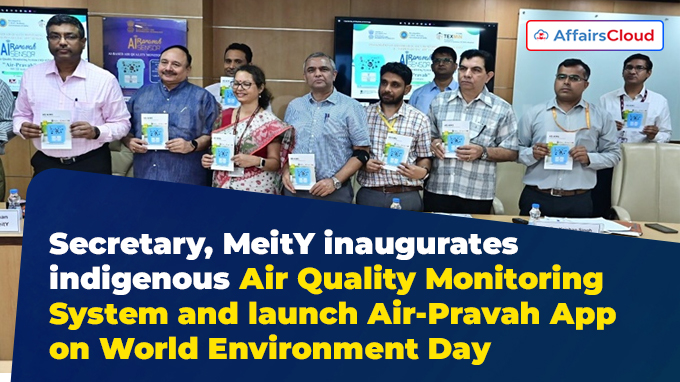 On the occasion of World Environment Day 2024 (5th June 2024), S Krishnan, Secretary of the Ministry of Electronics and Information Technology (MeitY), inaugurated the Indigenous Air Quality Monitoring System (AQ-AIMS) during the event held in New Delhi, Delhi.
On the occasion of World Environment Day 2024 (5th June 2024), S Krishnan, Secretary of the Ministry of Electronics and Information Technology (MeitY), inaugurated the Indigenous Air Quality Monitoring System (AQ-AIMS) during the event held in New Delhi, Delhi.
- He also launched the mobile application “Air-Pravah” for real-time Air Quality Index (AQI) monitoring.
- The AQ-AIMS and Air-Pravah were developed under MeitY-supported technologies.
About AQ-AIMS:
i.It is a cost-effective system to keep track of AQI more effectively and is built under the “Make in India” initiative led by the Government of India (GoI).
ii.The system was developed by Kolkata (West Bengal) based- Centre for Development of Advanced Computing (C-DAC) in partnership with Technology Innovation in Exploration and Mining (TeXMIN), Indian School of Mines (ISM), Dhanbad (Jharkhand) and J M Envirolab Private Limited under the “National Programme on Electronics and ICT Applications in Agriculture and Environment (AgriEnIcs)”.
iii.It is an outdoor air quality monitoring system to track environmental pollutants which includes various parameters such as Particulate Matter(PM) less than 1 micron (PM 1.0), PM 2.5, PM 10, Sulphur Dioxide (SO2), Nitrogen Dioxide (NO2), Ozone (O3), Carbon Monoxide (CO), Carbon Dioxide (CO2), Temperature, Humidity, among others, for continuous air quality monitoring.
iv.On successful completion of field trial, the system received certification from National Physical Laboratory of India(NPL), Delhi; TUV India Private Limited, Pune (Maharashtra).
v.Now, the system is being commercialised by the TOT partner M/s J M Envirolab Private Limited. AQ-AIMS system will be available on Government e-Marketplace (GeM) portal.
About Air- Pravah:
i.Air- Pravah offers fast setup, real-time data visualisation, unit conversions, AQI comparison, multi-device support, data analysis tools, remote monitoring and automatic updates.
iii.The mobile application will be available on Android Play stores, and the app will be activated when registered with the unique device ID of the AQ-AIMS device.
Bihar’s Nagi & Nakti Bird Sanctuaries Designated as RAMSAR sites
On the occasion of World Environment Day 2024, the government of India (GoI) has designated Bihar’s Nagi Bird Sanctuary and Nakti Bird Sanctuary as wetlands of International Importance under the Ramsar convention, taking the total number of RAMSAR sites in India to 82.
- These wetlands are man-made reservoirs located in the Jhajha Forest Range of Jamui district, Bihar.
Note: The countries with the most RAMSAR Sites are the United Kingdom with 175 and Mexico with 144. China and India shares the 3rd spot with 82 RAMSAR sites each.
About Nagi Bird Sanctuary:
i.This, 200 hectare wetland, was formed after the construction of the Nagi dam on the Nagi River.
ii.It is a prime location for migrating birds in the winter season from October to April. This comprises about 3% of the global population of Bar-headed Geese (Anser Indicus).
iii.It provides habitats for over 75 bird species, 33 fish and 12 aquatic plants.
iv.This was declared as Bird Sanctuary in 1984 and has also been designated as an Important Bird Area (IBA) by Birdlife International.
About Nakti Bird Sanctuary:
i.It is developed primarily for irrigation purposes through the construction of Nakti dam.
ii.It provide habitat for over 150 species of birds, mammals, fish, aquatic plants and reptiles etc including globally threatened species like endangered Indian Elephant (Elephas maximus indicus) and vulnerable native catfish (Wallago attu).
iii.This wetland was designated as a Bird Sanctuary in 1984 due to its importance as wintering habitat for several migratory species, including the largest congregations of Red-Crested Pochard (Netta rufina) on the Indo-Gangetic plain.
Additional info: In February 2024, 5 wetlands from India were designated as RAMSAR Sites. This includes Ankasamudra Bird Conservation Reserve Aghanashini Estuary and Magadi Kere Conservation Reserve from Karnataka; and Karaivetti Bird Sanctuary and Longwood Shola Reserve Forest from Tamil Nadu.
About Ramsar Convention:
Convention on Wetlands or Ramsar Convention on Wetlands of International Importance was adopted in Ramsar, Iran on 2nd February 1971 and came into force in 1975. India ratified the convention on 1st February 1982.




